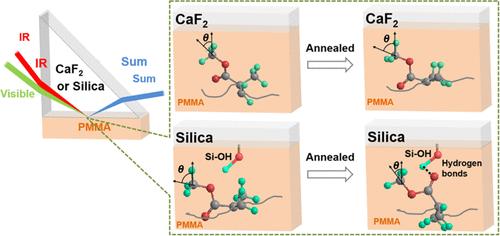通过和频谱振动光谱揭示不同埋藏界面上的聚甲基丙烯酸甲酯分子结构
IF 3.9
2区 化学
Q2 CHEMISTRY, MULTIDISCIPLINARY
引用次数: 0
摘要
二氧化硅或氟化钙(CaF2)基底支撑的聚(甲基丙烯酸甲酯)(PMMA)薄膜作为绝缘层通常用于光电/光伏设备,以提高这些设备的效率或稳定性。然而,在热刺激下,对埋藏在 PMMA/二氧化硅和 PMMA/CaF2 界面的分子结构进行的比较研究仍有待探索。在本研究中,我们利用和频发生(SFG)振动光谱定性和定量地揭示了退火前后两个界面上 PMMA 不同的分子排序和取向。通过使用各种氚代 PMMA,对 SFG 振动进行了仔细分配。SFG 结果表明,在埋藏的 PMMA/二氧化硅界面上,侧面的 OCH3 基团在退火前容易下垂,而在退火后则倾向于上挺。与此相反,在埋入的 PMMA/CaF2 界面上,情况恰好相反。两种基底的相对疏水性/亲水性以及在埋入 PMMA/二氧化硅界面退火后形成的氢键(在 CaF2 表面不存在)被认为是形成不同界面分子结构的驱动力。这项研究有助于从分子层面理解聚合物在埋藏界面上的界面局部结构弛豫,并从分子层面合理设计光电/光伏器件。本文章由计算机程序翻译,如有差异,请以英文原文为准。

Molecular Structures of Poly(methyl methacrylate) at Different Buried Interfaces Revealed by Sum Frequency Generation Vibrational Spectroscopy
Silica or calcium fluoride (CaF2) substrate-supported poly(methyl methacrylate) (PMMA) thin films as insulating layers are commonly used in photoelectric/photovoltaic devices to improve the efficiency or stability of these devices. However, a comparative investigation of molecular structures at buried PMMA/silica and PMMA/CaF2 interfaces under thermal stimuli remains unexplored. In this study, we qualitatively and quantitatively revealed different molecular orderings and orientations of PMMA at two interfaces before and after annealing using sum frequency generation (SFG) vibrational spectroscopy. SFG vibrations were carefully assigned by using various deuterated PMMAs. SFG results indicated that, at the buried PMMA/silica interface, the side OCH3 groups were prone to lie down before annealing and tended to stand up after annealing. In contrast, the case was the opposite at the buried PMMA/CaF2 interface. The relative hydrophobicity/hydrophilicity of the two substrates and the developed hydrogen bonds upon annealing at the buried PMMA/silica interface, which is absent at the CaF2 surface, are believed to be the driving forces for different interfacial molecular structures. This study benefits the molecular-level understanding of the interfacial local structural relaxation of polymers at buried interfaces and the rational design of photoelectric/photovoltaic devices from the molecular level.
求助全文
通过发布文献求助,成功后即可免费获取论文全文。
去求助
来源期刊

Langmuir
化学-材料科学:综合
CiteScore
6.50
自引率
10.30%
发文量
1464
审稿时长
2.1 months
期刊介绍:
Langmuir is an interdisciplinary journal publishing articles in the following subject categories:
Colloids: surfactants and self-assembly, dispersions, emulsions, foams
Interfaces: adsorption, reactions, films, forces
Biological Interfaces: biocolloids, biomolecular and biomimetic materials
Materials: nano- and mesostructured materials, polymers, gels, liquid crystals
Electrochemistry: interfacial charge transfer, charge transport, electrocatalysis, electrokinetic phenomena, bioelectrochemistry
Devices and Applications: sensors, fluidics, patterning, catalysis, photonic crystals
However, when high-impact, original work is submitted that does not fit within the above categories, decisions to accept or decline such papers will be based on one criteria: What Would Irving Do?
Langmuir ranks #2 in citations out of 136 journals in the category of Physical Chemistry with 113,157 total citations. The journal received an Impact Factor of 4.384*.
This journal is also indexed in the categories of Materials Science (ranked #1) and Multidisciplinary Chemistry (ranked #5).
 求助内容:
求助内容: 应助结果提醒方式:
应助结果提醒方式:


